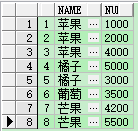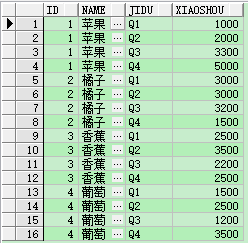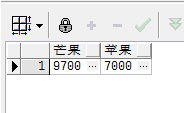Oracle行转列、列转行的Sql语句总结
多行转字符串
这个比较简单,用||或concat函数可以实现
SQL Code
| 1 |
|
select concat(id,username) str from app_user |
字符串转多列
实际上就是拆分字符串的问题,可以使用 substr、instr、regexp_substr函数方式
字符串转多行
使用union all函数等方式
wm_concat函数
首先让我们来看看这个神奇的函数wm_concat(列名),该函数可以把列值以","号分隔起来,并显示成一行,接下来上例子,看看这个神奇的函数如何应用准备测试数据
SQL Code
| 1 |
|
create table test(id number,name varchar2(20)); |
效果1 : 行转列 ,默认逗号隔开
SQL Code
| 1 |
|
select wm_concat(name) name from test; |
效果2: 把结果里的逗号替换成"|"
SQL Code
| 1 |
|
select replace(wm_concat(name),',','|') from test; |
效果3: 按ID分组合并name
SQL Code
| 1 |
|
select id,wm_concat(name) name from test group by id; |
sql语句等同于下面的sql语句:
SQL Code
| 1 |
|
-------- 适用范围:8i,9i,10g及以后版本 ( MAX + DECODE ) |
懒人扩展用法:
案例: 我要写一个视图,类似"create or replace view as select 字段1,...字段50 from tablename" ,基表有50多个字段,要是靠手工写太麻烦了,有没有什么简便的方法? 当然有了,看我如果应用wm_concat来让这个需求变简单,假设我的APP_USER表中有(id,username,password,age)4个字段。查询结果如下
SQL Code
| 1 |
|
/** 这里的表名默认区分大小写 */ |
利用系统表方式查询
SQL Code
| 1 |
|
select * from user_tab_columns |
Oracle 11g 行列互换 pivot 和 unpivot 说明
在Oracle 11g中,Oracle 又增加了2个查询:pivot(行转列) 和unpivot(列转行)
参考:http://blog.csdn.net/tianlesoftware/article/details/7060306、http://www.oracle.com/technetwork/cn/articles/11g-pivot-101924-zhs.html
google 一下,网上有一篇比较详细的文档:http://www.oracle-developer.net/display.php?id=506
pivot 列转行
测试数据 (id,类型名称,销售数量),案例:根据水果的类型查询出一条数据显示出每种类型的销售数量。
SQL Code
| 1 |
|
create table demo(id int,name varchar(20),nums int); ---- 创建表 |
分组查询 (当然这是不符合查询一条数据的要求的)
SQL Code
| 1 |
|
select name, sum(nums) nums from demo group by name |
行转列查询
SQL Code
| 1 |
|
select * from (select name, nums from demo) pivot (sum(nums) for name in ('苹果' 苹果, '橘子', '葡萄', '芒果')); |
注意: pivot(聚合函数 for 列名 in(类型)) ,其中 in('') 中可以指定别名,in中还可以指定子查询,比如 select distinct code from customers
当然也可以不使用pivot函数,等同于下列语句,只是代码比较长,容易理解
SQL Code
| 1 |
|
select * |
unpivot 行转列
顾名思义就是将多列转换成1列中去
案例:现在有一个水果表,记录了4个季度的销售数量,现在要将每种水果的每个季度的销售情况用多行数据展示。
创建表和数据
SQL Code
| 1 |
|
create table Fruit(id int,name varchar(20), Q1 int, Q2 int, Q3 int, Q4 int); |
列转行查询
SQL Code
| 1 |
|
select id , name, jidu, xiaoshou from Fruit unpivot (xiaoshou for jidu in (q1, q2, q3, q4) ) |
注意: unpivot没有聚合函数,xiaoshou、jidu字段也是临时的变量
同样不使用unpivot也可以实现同样的效果,只是sql语句会很长,而且执行速度效率也没有前者高
SQL Code
| 1 |
|
select id, name ,'Q1' jidu, (select q1 from fruit where id=f.id) xiaoshou from Fruit f |
XML类型
上述pivot列转行示例中,你已经知道了需要查询的类型有哪些,用in()的方式包含,假设如果您不知道都有哪些值,您怎么构建查询呢?
pivot 操作中的另一个子句 XML 可用于解决此问题。该子句允许您以 XML 格式创建执行了 pivot 操作的输出,在此输出中,您可以指定一个特殊的子句 ANY 而非文字值
示例如下:
SQL Code
| 1 |
|
select * from ( |
如您所见,列 NAME_XML 是 XMLTYPE,其中根元素是
对于该xml文件的解析,贴代码如下:
SQL Code
| 1 |
create or replace procedure ljz_pivot_xml_sp(pi_table_name varchar2, |
第一个参数为要解析xml文件所属数据表,第二个参数为要解析xml所存字段,第三个参数存放解析后的数据集。
测试:
begin
ljz_pivot_xml_sp('(select * from (select deptno,sal from emp) pivot xml(sum(sal) for deptno in(any)))',
'deptno_xml',
'ljz_pivot_tmp');
end;
初学oracle xml解析,这种方法较为笨拙,一个一个循环列,原型如下:
select extractvalue(name_xml, '/PivotSet/item[1]/column[1]')
from (select * from (select name,nums from demo) pivot xml(sum(nums) for name in(any))) x
where existsnode(name_xml, '/PivotSet/item[1]/column[1]') = 1;
select x.*
from (select *
from (select name, nums from demo)
pivot xml(sum(nums)
for name in(any))) a,
xmltable('/PivotSet' passing a.name_xml columns
芒果 varchar2(30) path 'item[1]/column[2]',
苹果 varchar2(30) path 'item[2]/column[2]') x
不知是否存在直接进行解析的方法,这种方法还不如直接行列转变,不通过xml转来转去。
select '''' || listagg(substr(name, 1, 30), q'{','}') within group(order by name) || ''''
from (select distinct name from demo);
select *
from (select name, nums from demo)
pivot(sum(nums)
for name in('苹果', '橘子', '葡萄', '芒果'));
这样拼接字符串反而更加方便。
结论
Pivot 为 SQL 语言增添了一个非常重要且实用的功能。您可以使用 pivot 函数针对任何关系表创建一个交叉表报表,而不必编写包含大量 decode 函数的令人费解的、不直观的代码。同样,您可以使用 unpivot 操作转换任何交叉表报表,以常规关系表的形式对其进行存储。Pivot 可以生成常规文本或 XML 格式的输出。如果是 XML 格式的输出,您不必指定 pivot 操作需要搜索的值域。
» 下一篇: Oracle用法、函数备忘记录









